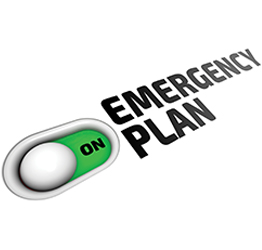Empowering the small business community
with emergency preparedness
By Andrea E. Davis
Today, there are over 30 million small businesses in the United States, employing over 60 million people, according to U.S. Chamber of Commerce small business statistics. Small businesses—defined by the Small Business Administration as firms with 500 or fewer employees—account for 99.9% of all businesses in the United

States, making them the true backbone of the American economy. Furthermore, small businesses have a greater impact on their local community than a larger big box/chain business, because a small business generally recirculates 30% to 33% of revenues back into their community.
Unfortunately, United States Chamber of Commerce small business statistics indicate that 40% of these small businesses will not make it to the five-year mark. Lack of market demand is the number one reason why a small business doesn’t make it to its fifth anniversary; however, data show that not anticipating risks and business disruptions are a close second cause for a small business or organization to fail.
Currently, crisis and business continuity planning strategies are not a required element of a business plan. I argue it should be, and I would take that a step further by having insurance companies require a business to have a business continuity plan before providing insurance coverage to the business. By inserting this simple requirement, the overall insurance market could decrease community risk and help a business keep its doors open following a crisis.
Preparing for a crisis should become part of doing business every day.
I have spent nearly 25 years in the emergency management field supporting small nonprofits and businesses, large government organizations, and the Fortune 500 prepare for and respond to a variety of crises. I have observed that, regardless of sector or size, those organizations that had crisis plans in place were able to pivot operations and mitigate the impact of a crisis or business disruption. However, those that didn’t have plans were significantly impacted, some having to shut their doors for good.
I was part of the recovery efforts for two of the United States’ largest disasters: Hurricane Katrina and COVID-19. The impact on the small business community for both was significant. Looking at some statistics:
According to ABC News, following Hurricane Katrina:
- Some 125,000 small businesses in the Gulf Region closed their doors for more than six weeks
- 8,000 never reopened
The Small Business Association Office of Advocacy reports that, after COVID-19:
- 12 million-plus small businesses closed their doors for more than six weeks
- 200,000 small businesses permanently closed their doors
In both crises, I witnessed the following four themes amongst the business community:
- Lack of understanding of risks and their potential impact
- No knowledge of community resources
- Lack of planning and communication to employees
- No assessment of lessons learned
Just think of how different the outcomes could have been if the small businesses that closed their doors after Hurricane Katrina or COVID-19 had thought through how they might conduct business without their typical resources? What if they had spoken to their neighbors to understand their plans? What if they understood what resources might be available to them before and after each crisis?
I am sure you are asking yourself this: If crisis planning is so simple, then why isn’t it done by more businesses? What are the barriers? The number one reason I have found is perception—the perception that crisis planning is too complicated, and the business owner doesn’t have the time to learn it nor the money to hire someone to do it.
How I have been able to obtain buy-in from a business is through a four-pronged approach to crisis planning that can easily be incorporated into a simple business continuity plan. Specifically:
- Determine risks
- Look at all “Six Sides.” I like to utilize this first-aid strategy to determine and view risks holistically, looking both externally (natural hazards, human-made threats) and internally (economic losses, employee dissatisfaction).
- Determine where to invest limited time and money. After risks are determined, then prioritize them and figure out strategies to either accept, mitigate, or defer each risk.
- Establish duty of care. Ask how you will help your employees during a crisis situation.
- Establish continuity of operations
- Outline critical functions. What functions must continue in order for the business to keep its “doors open” and how will you continue to do them?
- Define important assets and resources. How will you protect them during a crisis? (Hint: Em-ployees should be one of them.)
- Determine the business’s immediate actions, its actions over the first five days, and its actions 30 days after a crisis.
- Understand a business’s third- party vendors’ plans and procedures in a crisis.
- Ask if there are any compliance issues that need to be considered.
- Decide insurance coverage options and if there are any discounts available for having crisis/continuity plans in place.
I have observed that, regardless of sector or size, those
organizations that had crisis plans in place were
able to pivot operations and mitigate the impact of a crisis or business disruption.
- Understand available resources
- Know the capabilities of the business’s neighborhood (first responder time frames, proximity to gas, grocery stores, and other commodities).
- Reach out to local offices of emergency services/management. Most offer free classes and resources; some have specific outreach programs to the business community.
- Sign up for emergency notifications either through the state or local office of emergency services/management.
Preparing for a crisis should
become part of doing business every day.
- Communicate and practice plans
- Once the business understands its risks and resources and develops a simple plan, it should communicate and practice it with its employees and neighbors if appropriate.
- Crisis planning should become part of the family “dinner table” as well. If a business owner or the business’s employees don’t have personal plans in place, their focus will not be on the business in the time of crisis.
 The author
The author
Andrea Davis is president and CEO of The Resiliency Initiative (TRI), a Women-Owned Small Business (WOSB). A recognized expert in the field of emergency management, she has dedicated her career to bridging the silos between the public and private sectors to create a united approach when it comes to disaster risk reduction. Ms. Davis has held leadership roles with NGOs (The American Red Cross, Save the Children U.S.), the U.S. Federal Government (FEMA, The Federal Reserve) and Fortune 500 Companies (Walmart, Disney). In each, she used her influence to lead global initiatives focused on the importance of making risk-informed determinations and engaging all members of the community in the decision-making process. Ms. Davis founded TRI out of a passion to serve the whole community before, during, and after an emergency. For more information, visit theresiliencyinitiative.com.






